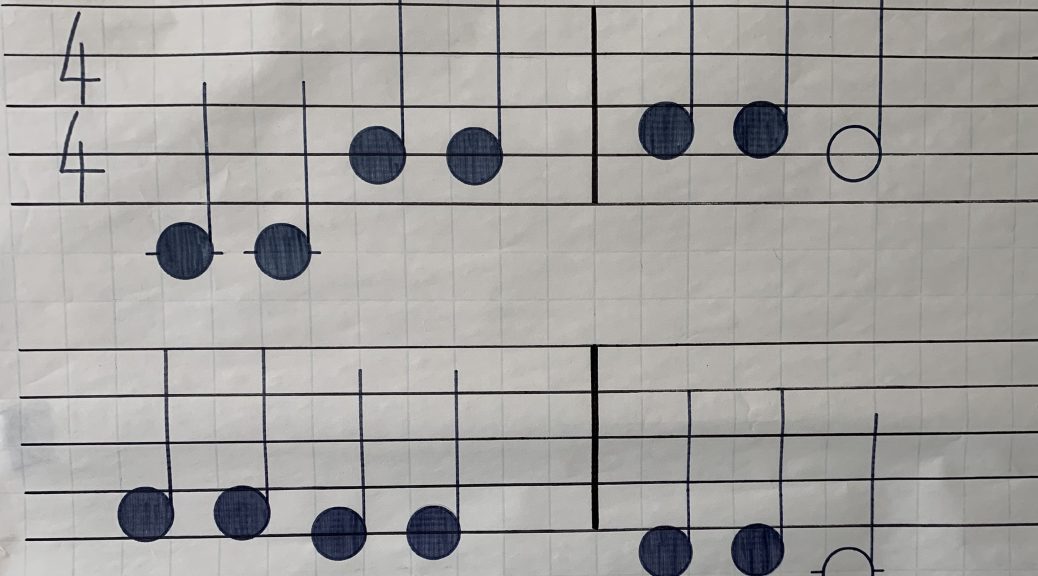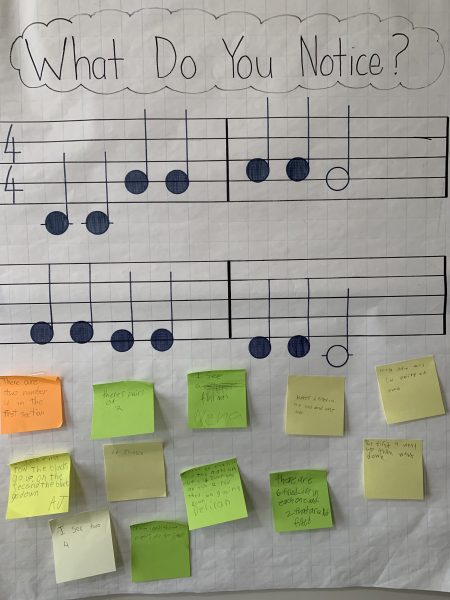
What Do You Notice? Musical Math Notes
Back in November, I sent out a newsletter with a new activity I had created for my Family Math Night: Musical Math Notes. I got a lot of great comments on it so I thought I’d share the What Do You Notice? poster that I also included at that event. A What Do You Notice? poster gives students (and their families) an opportunity to think about and share their thoughts about the math they see on the poster.

But I’ll admit, this poster was tougher than my other What Do You Notice? posters. Unless you’ve had some exposure to reading music, and many of the parents at the event had not, then it was hard to notice something musically math related. That said, I thought some of the comments were pretty good. I’ve included examples at the end.
Here’s the background information:
If you’re familiar with reading music, you can probably hum the tune. If you’re interested, see if you can figure it out before reading on.
Did you get Twinkle Twinkle Little Star?
To dive into the math part of this, you need to know that the five horizontal lines and the four spaces in between is called the staff (or stave). Each line or space represents a different musical pitch. This staff is broken into measures (sometimes called bars). You can easily identify each measure because they’re separated by bar lines – the dark vertical line. I included four measures for this activity.
The 4/4 at the beginning of the first measure indicates the beat of the music. The top number tells how many beats in each measure and the bottom number tells which note value receives one beat. Each measure gets the same beats. In our case, there are 4 beats per measure and a quarter note gets one beat.
I was actually hoping that the Musical Math Notes station activity would offer some guidance in this area. But that didn’t seem to be the case. Next time, I would include the information on the Musical Math Notes table tent next to the What Do You Notice? poster so that participants who were not as familiar with reading music could make more connections between math and music.
That said, here was my idea:
Younger students could notice a whole bunch of circles with little “stems”. Some circles were colored in while others were not and some also had little lines coming off the sides. If they counted all the notes*, they would come up with 12 colored-in notes and two not colored-in. That’s a total of 14 notes. These little ones could also notice that there were two number ‘4’s. If they wanted to do a math problem, they could add 4 + 4 to get 8. Although 8 doesn’t tie in with the music, adding the numbers together to arrive at 8 is still something they could notice.
They could also notice that the notes on the top go mostly up and the notes on the bottom go down.
My goal for the older students was to get them to notice that each measure was 4 beats. But first they needed to notice that there were 4 measures. Next time, I may make the bars a different color to draw attention to them.
Once they noticed that there were 4 measures, they would discover that in the first and third measures, there were 4 quarter notes with each quarter note receiving one beat. In the second and fourth measures, there were two quarter notes and a half note. Each half note counts as two beats. Altogether, this short little piece of music consisted of 16 beats: 4 beats/ measure x 4 measures.
Although a little difficult to do at a Family Math Night event, with more teacher guidance, this would be a fabulous activity in the classroom!
Here are some of the things students noticed:
“There are two number 4 in the first section.”
“On the first row the blacks go up. On the second the blacks go down.”
“There are 6 filled in each one and 2 that are not filled.”
“There’s pairs of 2.”
*Because I tied this in with my Musical Math Notes station, my goal was to have students learn that these circles with stems were called notes.